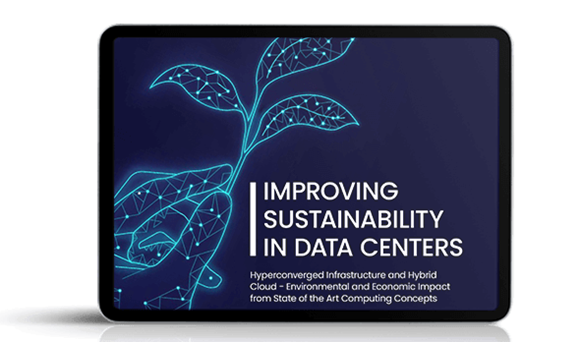Green coding - Nutanix report: Energy efficient datacentres could save billions
The green coding imperative is real and it stems from the ground up (i.e. the command line) and from the cloud down.
As we continue to pursue initiatives in this space, it’s worth reflecting upon the “shared responsibility” factors that govern the way we approach and consume enterprise technologies at the platform level.
Some of the discussion here gravitates around the shared responsibility that exists between customers who consume public (and indeed private, or hybrid) cloud services at the application deployment end – who need to think about compute efficiency and where they can refactor (or perhaps retire) some legacy applications and data services – and the cloud providers who supply the datacentre pipes in the first place.
It feels like the message has really gotten through at the developer level. Not to suggest that there is any overly-woke level of acceptance here and we clearly do still need to champion these issues, but perhaps it’s time to look a little deeper into the backend.
Zoning in on the cloud datacentre side of the argument, a new report has emerged this month from hybrid multi-cloud computing company Nutanix which suggests that billions could be saved if we take a more sustainable approach to datacentre development, operation and management.
Improving sustainability
Carried out by digital advisory and analytics company Atlantic Ventures’, the Improving Sustainability in Data Centers 2024 suggests methods and means for next-generation datacentre architectures, including an analysis of how hybrid cloud and hyperconverged infrastructure (HCI) can reduce energy consumption, lower carbon emissions and drive cost savings.
In what could be “just” six years, the report finds that modernising datacentres with HCI-based solutions could save up to 19 million tCO2e in the EMEA region, equivalent to the emissions of almost 4.1 million cars. It could also save €25 billion by 2030 from improved energy and operational efficiencies.
NOTE: As per its use above, tCO2e stands for Tonnes of Carbon Dioxide Equivalent, sometimes written as ton, but always relating to a metric tonne i.e. 1000 kilograms.
Post-Covid digitisation
Nutanix says that as businesses now work towards the reality of post-Covid digitisation and the demands for data-hungry technologies, such as AI and IoT, this report identifies an increasing urgency for action. The dual challenges of rising energy costs and increased regulatory pressure to reduce their environmental impact are making this more difficult for IT leaders. As a result, energy efficiency has become a top priority for CIOs and data centre managers.
“Datacentres are critical to the global digital economy but also rank among the largest consumers of energy,” says Sammy Zoghlami, SVP EMEA at Nutanix. “In EMEA alone, datacentres demand over 98 TWh of energy annually, equivalent to the consumption of an entire country like Belgium. The findings of this report show that by leveraging HCI-based solutions, companies can make a powerful contribution to climate action while significantly cutting operational costs.”
Atlantic Ventures used a study method to analyse a typical Western European enterprise datacentre, comparing traditional 3-Tier infrastructure to HCI-based systems in terms of energy consumption, carbon emissions and operational costs.
UK-specific data
In terms of UK-specific data put forward here, Atlantic Ventures says that switching from traditional 3-Tier architectures to an HCI-based platform can reduce energy consumption by more than 27% annually.
Across the EMEA region, a full-scale transition could save up to 92 TWh of electricity and eliminate 19 million tons of CO₂e between 2024 and 2030, this amount would equate to savings of 13.4 TWh of electricity.
NOTE: The European Commission defines Terawatt hours, abbreviated as TWh, is a unit of energy representing one trillion watt hours.
“CIOs and digital executives are facing challenges to provide the digital infrastructure to cope with the fast-growing demand for compute power and storage capacity, especially with the emergence of AI applications,” says Dr. Carlo Velten, co-founder of Atlantic Ventures. “As IT budgets are under pressure and electricity prices are soaring, energy efficient data centre and cloud operations are key levers for profitability and sustainability. Hyperconverged infrastructure is at the forefront of transforming data centres into more energy-efficient and climate-friendly operations, as this report confirms.”
Other suggestions made here include the notion that HCI-based architecture also enables lean, energy-efficient disaster recovery systems in the cloud, reducing the infrastructure footprint while maintaining scalability and responsiveness
“The financial windfall from reduced electricity consumption could reach €25 billion by 2030, offering businesses a rare opportunity to align sustainability with profitability. Due to relatively high price levels for electricity, the potential electricity cost savings for companies and service providers in the UK could be as much as 3,3 billion euros between 2024 – 2030 when switching on-premises from 3-Tier to HCI,” stated Nutanix, in its summary overview of these findings.
 Migrating HCI platforms to co-location or public cloud environments is argued to magnify these benefits, with potential energy savings reaching as high as 54% compared to traditional on-premise datacentres. This is due to the low PUE of Public Cloud Providers as well as the flexibility in providing on-demand computing capacity.
Migrating HCI platforms to co-location or public cloud environments is argued to magnify these benefits, with potential energy savings reaching as high as 54% compared to traditional on-premise datacentres. This is due to the low PUE of Public Cloud Providers as well as the flexibility in providing on-demand computing capacity.
Worldwide datacentre landscape
Where does all this leave us?
In a world where developing nations in the East and West may (arguably) be putting industrial-scale production (in both digital spaces and in physical manufacturing terms) ahead of climate-related sustainability concerns, is it the role of nations like the UK to promise research and innovation in cloud efficiency in the hope that – for its cost savings if nothing else – that these methods and practices are adopted elsewhere? Many would argue yes and Nutanix specifically suggests that the UK‘s strategic position and tech infrastructure continue to attract investments to make it a significant player in the worldwide datacentre landscape.




